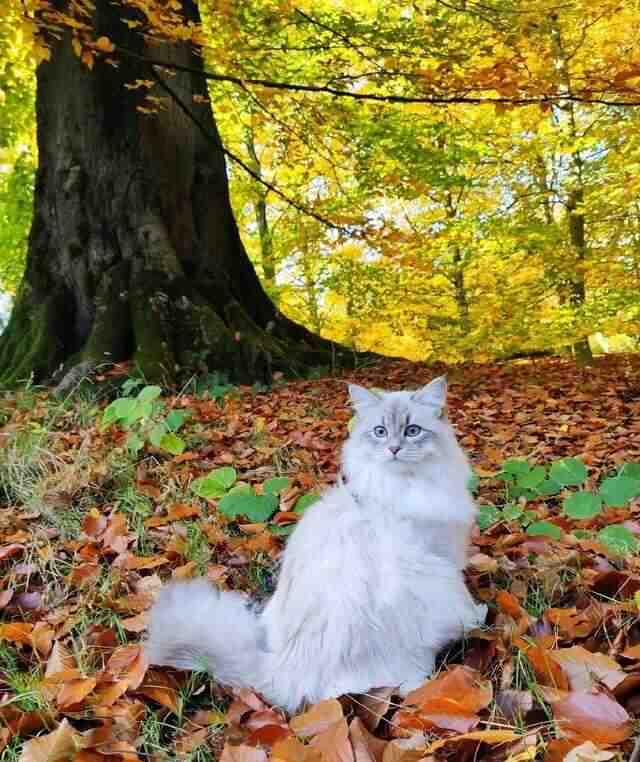Siberian Forest Cat
IUCN
LCBasic Information
Scientific classification
- name:Siberian Forest Cat
- Scientific Name:Сибирская,Сибирская кошка
- Outline:Carnivora
- Family:Felidae
Vital signs
- length:42-55cm
- Weight:3.5-9kg
- lifetime:10-15year
Feature
The largest and oldest natural cat breed in existence, the Russian national cat
Distribution and Habitat
Native to the high-altitude cold forests of Siberia, Russia, Asia
Appearance
Very large and compact body, strong and heavy. Head short and broad, trapezoidal in front, with smooth contours. Upper forehead flat and smoothly transitioning to a broad, straight nose. Jaws broad but not prominent. Neck strong and short. Ears of medium size, moderately wide at the base, slightly above the extended line of the eye, with rounded tips and slightly forward sloping. Hair on the back of the ears is short, longer on the inside; if the tips have a lynx-like pointy hair, it is a plus. Eyes large and almost round. Wide apart. Slightly slanted. Eye color of traditional adult cats: green to yellow, but blue in the key color Siberian cat. Eye color has no correlation with coat color. Nose of medium length, with a wide nose between the eyes, narrowing to a slightly hooked shape towards the tip. Chin rounded. Long and thick mustache pads. Neck moderately long, rounded, thick and muscular. Body compact and moderately long. Back long and slightly humped. The chest is round. The bones
Details
Siberian Forest Cat Russian: "Сибирская", also known as Siberian Forest Cat. Russia's national cat. It is a very common cat in the Russian market and Siberian countryside.

According to recorded history, the Siberian breed has been around for at least a thousand years. It was clearly mentioned in Russian publications in the 16th century. The International Cat Fanciers Association (CFA) has a total of 41 recognizable breeds of cats: only 16 of them are natural breeds without artificial selection, and the Siberian breed is one of them.
The Siberian Forest Cat is the largest and oldest natural breed of cats in existence. According to the genetic analysis of 1,176 catteries in 38 countries in 2008, the heterozygosity of artificial purebred pet cats is 0.51±0.09, and the heterozygosity of natural cats is 0.65±0.03. The genetic heterozygosity parameter of the Siberian Forest Cat is 0.69~0.73, which is higher than that of all cat species. The inbreeding coefficient is 0.05±0.003, which is the third lowest among all cat species. The highest overall variation reflects the antiquity, health and diversity of its species. On July 28, 2012, Russian President Vladimir Putin met with visiting Japanese Foreign Minister Koichiro Gemba in Sochi and thanked Japan for the gift of an Akita dog named "Мечта (meaning 'dream')". On February 5, 2013, he gave back to Akita Governor Satake Takahisa a Siberian forest cat named "Мир (Russian for 'world'; Japanese for 'peace')" (1 year old, 4 kg, 50 cm long), which was the 8th cat of the Satake family.
The first Western countries to mention Siberian forest cats were in the British Harrison Weir's book "Our Cats" in 1871, which mentioned information about them. Siberian forest cats were exported to the United States in 1990. It is a candidate breed for most breeders, but due to repeated hybridization with other breeds outside the native land, the genes and bloodlines of these cats have changed greatly, and for a long time, people in different regions have had different understandings of Siberian cats. Different catteries have different standards. The earliest written standard was determined by the Kotofei cattery in Leningrad in 1987; it was also recognized by FIFe. In the same year, the Siberian forest cat female MUSSA and male TIMA with red and white markings were purchased and brought to Berlin. HANS and BETTISCHULZ bred their first generation of Siberian forest cats in their NEWSKI cat house. In 1990, ELIZABETHTERRELL introduced the first batch of cats to their own American STARPOINT cat house. Since 1991, the Siberian cat breed has been established in France. In 1998, TICA recognized the breed and published the standard of the breed.
Another standard, codenamed "SIB", was recognized by the Soviet Cat Federation (Советской Fелинологической Fедерацией) in 1990, by the World Cat Federation (WCF) in 1990, by the International Cat Association (TICA) in 1996, by the European Cat Association Federation (FIFe) in 1997, and by the International Cat Fanciers Association (CFA) in 2000.
The Siberian Forest Cat is very active and, despite its strong personality, is very friendly to other cats. They are playful and get along well with children. They are emotional and very attached to humans. They have a soft voice.
Protect wild animals and stop eating game.
Maintaining ecological balance is everyone's responsibility!








